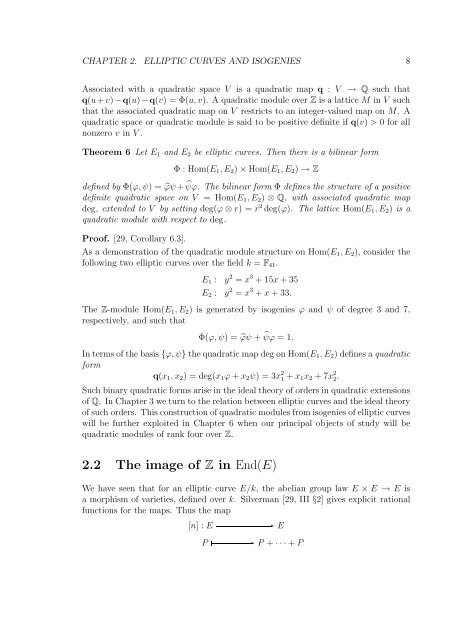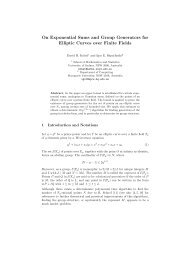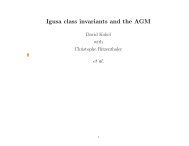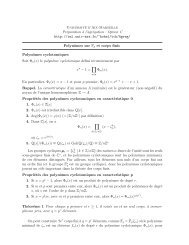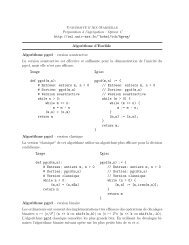Endomorphism rings of elliptic curves over finite fields by David Kohel
Endomorphism rings of elliptic curves over finite fields by David Kohel
Endomorphism rings of elliptic curves over finite fields by David Kohel
You also want an ePaper? Increase the reach of your titles
YUMPU automatically turns print PDFs into web optimized ePapers that Google loves.
CHAPTER 2. ELLIPTIC CURVES AND ISOGENIES 8Associated with a quadratic space V is a quadratic map q : V → Q such thatq(u+v) −q(u) −q(v) = Φ(u, v). A quadratic module <strong>over</strong> Z is a lattice M in V suchthat the associated quadratic map on V restricts to an integer-valued map on M. Aquadratic space or quadratic module is said to be positive de<strong>finite</strong> if q(v) > 0 for allnonzero v in V .Theorem 6 Let E 1 and E 2 be <strong>elliptic</strong> <strong>curves</strong>. Then there is a bilinear formΦ : Hom(E 1 , E 2 ) × Hom(E 1 , E 2 ) → Zdefined <strong>by</strong> Φ(ϕ, ψ) = ̂ϕψ+ ̂ψϕ. The bilinear form Φ defines the structure <strong>of</strong> a positivede<strong>finite</strong> quadratic space on V = Hom(E 1 , E 2 ) ⊗ Q, with associated quadratic mapdeg, extended to V <strong>by</strong> setting deg(ϕ ⊗ r) = r 2 deg(ϕ). The lattice Hom(E 1 , E 2 ) is aquadratic module with respect to deg.Pro<strong>of</strong>. [29, Corollary 6.3].As a demonstration <strong>of</strong> the quadratic module structure on Hom(E 1 , E 2 ), consider thefollowing two <strong>elliptic</strong> <strong>curves</strong> <strong>over</strong> the field k = F 41 .E 1 : y 2 = x 3 + 15x + 35E 2 : y 2 = x 3 + x + 33.The Z-module Hom(E 1 , E 2 ) is generated <strong>by</strong> isogenies ϕ and ψ <strong>of</strong> degree 3 and 7,respectively, and such thatΦ(ϕ, ψ) = ̂ϕψ + ̂ψϕ = 1.In terms <strong>of</strong> the basis {ϕ, ψ} the quadratic map deg on Hom(E 1 , E 2 ) defines a quadraticformq(x 1 , x 2 ) = deg(x 1 ϕ + x 2 ψ) = 3x 2 1 + x 1x 2 + 7x 2 2 .Such binary quadratic forms arise in the ideal theory <strong>of</strong> orders in quadratic extensions<strong>of</strong> Q. In Chapter 3 we turn to the relation between <strong>elliptic</strong> <strong>curves</strong> and the ideal theory<strong>of</strong> such orders. This construction <strong>of</strong> quadratic modules from isogenies <strong>of</strong> <strong>elliptic</strong> <strong>curves</strong>will be further exploited in Chapter 6 when our principal objects <strong>of</strong> study will bequadratic modules <strong>of</strong> rank four <strong>over</strong> Z.2.2 The image <strong>of</strong> Z in End(E)We have seen that for an <strong>elliptic</strong> curve E/k, the abelian group law E × E → E isa morphism <strong>of</strong> varieties, defined <strong>over</strong> k. Silverman [29, III §2] gives explicit rationalfunctions for the maps. Thus the map[n] : EP✲ E✲ P + · · · + P


